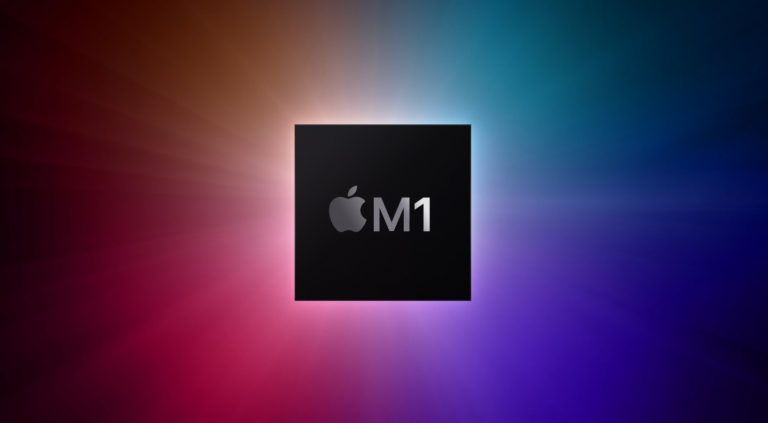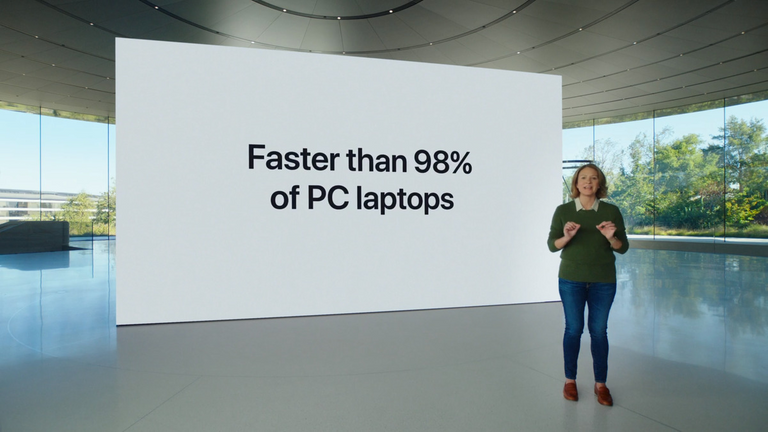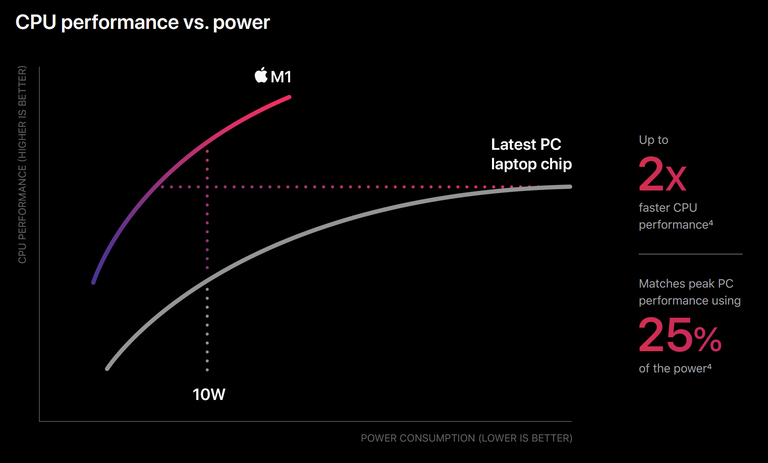
On Tuesday 10 November, Apple has presented its new silicon, the M1 chipset. That is a System-on-a-Chip (SoC) that Apple intends to complement and then replace the existing Intel processors in their laptops (MacBook Air and MacBook Pro) and desktop (Mac Mini).
From a technical point of view, it is the result of a decade of in-house silicon development that started when the A4 SoC was introduced in 2010 on the first-generation iPad; Apple created the A4 because it wanted to have full control over their processor design and integration, and that required taking ownership of the process. Since then, a family of processors has been developed through several generations, usually following the cadence of Apple's mobile platform: each new iPhone since 2010 has featured a new version of the chip.
Starting with the first-generation iPad Pro in 2015 and its dual-core A9X CPU, Apple started touting the performance of their silicon as "desktop-class", claiming that it would rival the power of general-purpose Intel CPUs and make the iPad Pro - which would present itself as a supersized, expensive 12.9" tablet - as fast as a laptop. That first attempt didn't quite work for everyone and even its performance predictably turned out to be not as fast as a laptop, but a trend was set. And while Apple quietly shifted the marketing pitch of their big boy tablet (implicitly proving that Microsoft was right altogether about their Surface concept), the performance comparison between their proprietary silicon and mainstream processors remained a mainstay of the product line.
When the 4th generation iPad Pro debuted in 2020, Apple upped the ante by saying that thanks to their eight-core A12Z SoC they were "faster and more powerful than most Windows PC laptops"; meanwhile, in the x86 camp Intel kept on missing the opportunity to deliver a compelling product roadmap which showed real innovation and, most crucially, a significant performance leap from one year to another. At that point, the most perceptive observers were quick to guess the next logical step could be a generational shift, transitioning their own productivity laptop - the MacBook - from the Intel architecture to a new ARM architecture powered by Apple silicon: these speculations were all confirmed on November 10, 2020, when the house of Cupertino officially revealed that their yearly model refresh of laptop lineup would, for the first time, be powered by the M1 System-on-Chip.
According to Apple, M1 is their first chip designed specifically for Mac, and "it delivers incredible performance, custom technologies, and revolutionary power efficiency". Both the keynote and the official page put a heavy emphasis on performance, stating that it is not just "the highest‑performance CPU we’ve ever built, by far" with "up to two times the CPU performance and two times the GPU performance" (compared to "latest‑generation high‑performance notebooks commercially available at the time of testing"), but also "the world’s fastest integrated graphics in a personal computer". And then, according to their newsroom presentation and keynote, "faster than the chips in 98 percent of PC laptops sold in the past year".

Right after this bombastic presentation, benchmarks have surfaced on GeekBench with some remarkable results, most notably showing that - at least with synthetic tests - the M1 is beating every Intel-powered MacBook pro.
Does it mean Apple's claims are true and we are witnessing a real revolution in personal computing, powered by a revolutionary chip that on its debut is beating all the competitors hands down?
No.
Just don't fall for the marketing spin, and use some reasoning instead.
First of all, remember the numbers on GeekBench result from synthetic benchmarks.
These are artificial programs that are constructed to try to match the characteristics of a large set of programs, which means the benchmarks itself does not perform a function outside of producing numbers and data used to provide a comparison.
In other words, synthetic benchmarks deliver a numeric score, which only makes sense if compared to the score of the same benchmark on a different machine; and most crucially, these scores do not give a useful idea of the actual performance of the system or component being tested.
On the opposite side, real-world benchmarks are applications that users would run in everyday life, which are equipped with a standard operation and data set to deliver a score that is reflecting the performance a user would obtain from that program. Real-world benchmarks are harder to interpret for the average consumer, but they also provide results that reflect the real performance of a system executing them and are therefore much more useful.
Apple did not provide any actual reference to their performance claims.
Reading the footnotes of the M1 page is a fascinating exercise, as it shows Apple's talent in avoiding any meaningful reference to the real world.

While stating that M1 has "up to two times faster CPU performance", it's carefully omitted "the CPU performance of what". The footnote, for those who care following it, details as follows:
- "Multithreaded performance measured using select industry‑standard benchmarks", which means "synthetic benchmarks" that, as explained, don't provide anything more than a numeric score and do not necessarily relate to any real-world performance.
- "Comparison made against latest‑generation high‑performance notebooks commercially available at the time of testing", which doesn't say anything about what brand, model, or CPU was used for comparison.
The first point indicates Apple has used synthetic benchmarks to measure their claimed 2x performance; synthetic benchmark scores make sense only when compared with the corresponding score of a known and well-defined machine, and the second point indicates that this "comparison" has been made against a completely undefined machine.
In other words, Apple's performance claims are baseless by their admission.
Even mainstream technical media expect the new computers to not match Apple's claims, as the "faster than 98% of PC laptops" is just baseless as it has no context, nor proof.
Transitioning to ARM is a minefield that has already made famous victims
Apple claims their new M1 chip has unprecedented performance and all the applications will run great, thanks to the optimizations built in the latest macOS version (Big Sur) that have been specifically designed for the new silicon, and backward compatibility provided by the new Rosetta 2 translation layer. As M1 is directly derived from the A-series chip that runs on iPhone and iPad, the new machines will also be able to natively run iOS apps, providing a tremendous amount of quality software available from day one.
However, Apple is not the first company to try transitioning to ARM-based computers: in fact, the same move was attempted by Microsoft - twice.
The first attempt was in 2012 with Surface RT: a sleek tablet that ran Windows RT, a stripped-down version of Windows 8 compiled for ARM that, confusingly, looked like Windows but could not install nor run traditional Windows applications (as those were compiled for the x86 architecture and were therefore not compatible). The failure of RT resulted in a $900 million loss by the end of 2013, due to inventory write-off.
That didn't prevent Microsoft from making another attempt, which resulted in the launch of the ARM-based Surface Pro X in 2019. Despite its attractive looks, a clever software compatibility layer to overcome the issue that killed RT, and a CPU co-developed by Microsoft and Qualcomm from their latest Snapdragon chip, Surface Pro X delivered an inconsistent performance with several applications being slower than an Intel system and others not working at all.
It's not just Microsoft though: several vendors (including Lenovo and Samsung) have tried their hand at ARM-based computers, which all resulted eventually affected by compatibility issues and underwhelming performance.
Interestingly, these computers are based on the Snapdragon 8cx SoC, whose synthetic benchmark score compared favorably to an 8th generation Intel i5. That shows once more what is the potential gap between synthetic benchmarks and real-world experience.
What performance are to expect from the new computers powered by Apple M1?
It is early to make any hard conclusion, and real results will become available only in the next weeks after media outlets and tech pundits will have the machines in their hands. Then it will be revealed what is their potential, and what these machines are capable of.
It is to be expected, however, that real-world benchmarks - such as Cinebench R20 - will see the latest generation CPUs from Intel and AMD crush the M1 mercilessly, and put it back where it belongs - possibly in the mid-low general performance tier. It is also predictable, based on the past track record of the best attempts at ARM-based general computing, that Apple computers powered by M1 chips will suffer compatibility issues, with common applications running slow, or not running at all.
Apple knows M1 computers are low-end devices
There is one single clear indication in the landslide of marketing material filled up with buzzwords, unreferenced graphs, and undefined comparisons that came with this new processor: Apple's marketing department knows that the M1 computers that just launched (the new MacBook Air, MacBook Pro, and Mac Mini) are low-end devices.
That is proven by their positioning: the Air and the Mini are the cheapest and most affordable laptop and desktop manufactured by Cupertino, and the M1-powered MacBook Pro has been introduced at the very base of the line. Interestingly, the latter also has the least number of connection ports of all MacBook Pros, and the least available amount of RAM configurable (up to 16GB while Intel models can be specced up to 32GB).
If the new M1-powered models are so incredibly capable - actually more powerful than all other Intel-based computers made by Apple today, by their own claims - why would Apple introduce the most powerful models at the lowest prices?
Marketing does not lie: the cheapest model is invariably the least capable, as it does not make sense to position it any other way.
One More Thing: don't buy a Mac Pro or a MacBook Pro 16
In all of this, one very undesirable yet possible thing - based on Cupertino's track record - is this new generation of ARM computers will push the current Intel machines into early obsolescence.
Why? Because it has happened several times in the past.
Apple began transitioning from Power PC by introducing the first Intel-based Mac in 2006; the final release of OS X 10.5 for PowerPC came out in October 2007 and two years later OS X 10.6 “Snow Leopard” was released in August 2009, without support for PowerPC Macs. In 2011 Apple ended all service and support for PowerPC, effectively terminating them all after only four years.
The 2012 Mac Pro - a prosumer device starting at $3000 - is not supported anymore starting from macOS 10.15 "Catalina", which was launched in 2019. In other words, Apple has stopped supporting one of its most expensive machines after only seven years.
Apple has a long history of shelving old hardware and kicking it aside to make room for new generation products: the risk that customers are possibly facing is sudden obsolescence in five years, purchasing one of the most expensive Apple computers today.
Yeah I am a bit skeptical about this whole thing as well, but I'm waiting some real life tests to see what the M1 is really about. I'm not sure if a CPU is reason enough to change from one laptop to another especially now that I've upgraded myself to a Ryzen7 on 7nm.
I think I'll wait for ARM to get more mainstream before jumping to a whole new computing platform
There are use cases where I expect M1 machines to do well, and bring actual improvements to end users: for instance, I have no problem believin their power consumption figures are excellent and that translates to 20 real hours of usage. And even midrange performance can be enough when the scenario involves browsing, email and personal productivity (e.g. Office / Google Docs).
Gaming on the other hand will likely be another blood bath, as Intel has just cracked it with their new Iris Xe integrated graphics. I'm ready to bet all M1 GPU comparisons were made against some 8th-gen Intel CPU with HD 600 graphics. Obviously that will be no challenge for a real graphics card.
Sure, I mean ARM machines are already known for their power efficiency so M1 not consuming as much power as a normal x86 CPU will come as no surprise, plus their 5nm technology should also help with that
There are use cases where I expect M1 machines to do well, and bring actual improvements to end users: for instance, I have no problem believin their power consumption figures are excellent and that translates to 20 real hours of usage. And even midrange performance can be enough when the scenario involves browsing, email and personal productivity (e.g. Office / Google Docs).
Gaming on the other hand will likely be another blood bath, as Intel has just cracked it with their new Iris Xe integrated graphics. I'm ready to bet all M1 GPU comparisons were made against some 8th-gen Intel CPU with HD 600 graphics. Obviously that will be no challenge for a real graphics card.